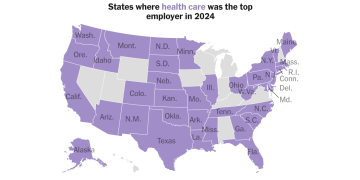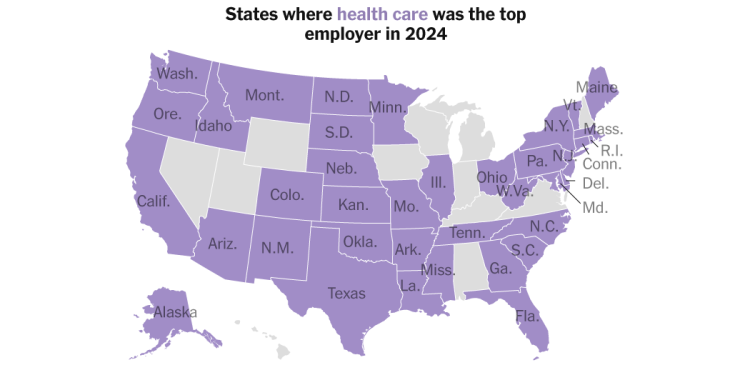For years, the United States labor market has been undergoing a structural transformation. As jobs in manufacturing have receded, slowly but steadily, the health care industry has more than replaced them.
The change has been particularly visible over the past year, during which health care has been responsible for about a third of all employment growth, while other categories, like retail and manufacturing, have stayed essentially flat.
Health care is the nation’s top employer
Share of total U.S. employment, 1990-2024
The nation’s corps of nurses, oncologists, lab technicians, anesthesiologists and other health-related workers has been growing steadily, through recession after recession, going from 9 percent of the total workforce in 2000 to 13 percent today. The government expects that trend to continue, as the nation ages and requires more care.
That blistering growth could cool, however, if Republicans in Congress succeed in passing their flagship tax and spending bill. The Senate version is estimated to cut Medicaid, which accounts for about a sixth of total health care spending, by about a trillion dollars over the next decade. About $82 billion would come out of other health care funding, including Medicare and subsidies under the Affordable Care Act.
“It’s going to put strain on the continued operations of quite a few health care providers,” said Brad Hershbein, a senior economist with the W.E. Upjohn Institute for Employment Research.
That’s mostly true for clinics and hospitals serving low-income areas. The Senate bill includes a $50 billion relief fund for rural hospitals, but it won’t be equally distributed and wouldn’t fully offset the Medicaid cuts. The legislation would also challenge academic medical centers, which are already reeling from a pullback in research grants. “Normally, they’re very resilient to various shocks, but this one is going to be different,” Dr. Hershbein said.
As much as politicians may focus on factory jobs, long idealized as the kind of work that could support a comfortable life for people without advanced degrees, health care is now playing that role for more people.
The field has seen much faster wage growth than non-health care occupations. Unlike in the broader economy, average pay increases have moved particularly quickly for middle-skilled roles such as nurses and physician’s assistants, while salaries for doctors have increased only moderately in percentage terms.
Pay has risen particularly quickly for nurses
Percentage change in average earnings, 1980-2022
That’s partly because, as the number of slots in medical school has remained limited, state lawmakers have allowed those with fewer years of training to handle more functions, like diagnosing illnesses and prescribing medications.
“It’s not like the economy just accepts, ‘Oh, I guess we won’t have enough doctors,’” says Joshua Gottlieb, an economist at the University of Chicago who recently co-wrote a paper on the subject. “New jobs are created.”
Health care jobs have been on the rise for three main reasons.
First, more people have been getting access to care. The uninsured rate has fallen to 8 percent in 2023 from 14 percent in 2000. That’s largely a result of the Affordable Care Act, which supported states in expanding Medicaid to more people, subsidized private insurance and pushed more employers to offer coverage.
Second, people with access to health care have been using more of it. Chronic conditions like kidney disease and cancer have become increasingly prevalent, while America is also getting older, necessitating more care.
And third, at least through the latter half of the 20th century, Americans consumed more health care because they were getting richer and spending less on other things. Globalization and mechanization made toasters and tomatoes much less expensive. But knee surgeries and nursing homes are still powered by people, who largely can’t be offshored or automated.
Americans now spend more on health care than groceries or housing
Share of U.S. household expenditures, 1929-2024
The rise of health care jobs is also visible geographically. In 38 states, the industry is now the biggest employer. Some former manufacturing hubs, like Cleveland and Pittsburgh, have transitioned to health care as a core driver of the local economy. And hospitals are often the largest employers in small towns and rural places, especially if they draw from a large surrounding area.
Although some policymakers emphasize the economic importance of manufacturing because it generates goods that can be exported to other countries, health care services are also exported. Foreigners come to U.S. hospitals for specialty procedures, foreign students study at U.S. medical schools, and drugs that go through U.S. clinical trials are sold worldwide.
And the heavy weighting of the workforce towards well being care isn’t distinctive. As international locations get richer and older, extra of their employment base shifts into medical fields. Though the US tends to spend extra on well being care as a share of its GDP, nine countries in the Organization for Economic Cooperation and Development, together with most of northern Europe and Japan, have larger shares of their working inhabitants in well being care than the US.
Hiring of health care professionals has been particularly swift over the last few years because the pandemic left a lot of catching up to do. Providers left the bedside en masse, exhausted by the relentless hours and dangerous conditions. Health care employment has still not caught up with its prepandemic trend, and job openings remain elevated over other industries.
Nursing schools have continued to churn out as many graduates as they can to keep up with vacancies.
Top employer in each state in 1990
Ala.
Alaska
Ariz.
Ark.
Calif.
Colo.
Conn.
Del.
Fla.
Ga.
Hawaii
Idaho
Ill.
Ind.
Iowa
Kan.
Ky.
La.
Maine
Md.
Mass.
Mich.
Minn.
Miss.
Mo.
Mont.
Neb.
Nev.
N.H.
N.J.
N.M.
N.Y.
N.C.
N.D.
Ohio
Okla.
Ore.
Pa.
R.I.
S.C.
S.D.
Tenn.
Texas
Utah
Vt.
Va.
Wash.
W.Va.
Wis.
Wyo.
Prime employer in every state in 2024
Ala.
Alaska
Ariz.
Ark.
Calif.
Colo.
Conn.
Del.
Fla.
Ga.
Hawaii
Idaho
Ill.
Ind.
Iowa
Kan.
Ky.
La.
Maine
Md.
Mass.
Mich.
Minn.
Miss.
Mo.
Mont.
Neb.
Nev.
N.H.
N.J.
N.M.
N.Y.
N.C.
N.D.
Ohio
Okla.
Ore.
Pa.
R.I.
S.C.
S.D.
Tenn.
Texas
Utah
Vt.
Va.
Wash.
W.Va.
Wis.
Wyo.
“There’s really not been a year where it’s like, ‘We’re good, we have all the nurses we need,’” said Robert Rosseter, chief communications officer for the American Association of Colleges of Nursing.
At the same time, new sources of demand have arisen. Virtual counseling and increasing support for mental health by employers and their insurance plans have created more jobs for therapists and counselors, both in private practice and at institutions like schools and hospitals.
Jon Guidi is the chief executive of HealthCare Recruiters International, which places staff on both a temporary and permanent basis. He said most intense shortages have eased, except for anything having to do with behavioral health, which he calls “massively underserved.”
“Wage escalation has been so high in that space,” Mr. Guidi said, “that the entities, whether it’s a home health company, a clinic, addiction treatment, eating disorders, their unit economics can’t keep up with the salary expectations now.”
It’s not inevitable, however, that health care employment will continue to grow at the same pace. One reason is looming cuts to federal health spending.
The Senate version of the Republicans’ large tax and spending bill, along with other changes by the Trump administration, would result in about 17 million fewer people having health insurance in 2034. Although people without health insurance tend to require more emergency care because they aren’t able to afford preventative visits, it’s not clear how those costs would be absorbed elsewhere. And those may not be the only cuts: The White House has also called for reductions in federal funding for medical education and research, which could constrict the supply of newly trained workers.
Health care is also getting somewhat more efficient. Many procedures can now be conducted on an outpatient basis. Recent pharmaceutical advances, such as diabetes medications that are now widely used for weight loss, appear likely to reduce the prevalence of chronic conditions related to obesity.
And artificial intelligence may be able to cut down on the 20 percent or so of health care employment that is administrative. Some of the tasks that currently burden doctors, nurses and radiologists could also be done more quickly with A.I.
David Cutler, a health care economist at Harvard University, cautions that while more people will be needed to deliver care in the future, the industry shouldn’t be seen as a jobs program. Costs have been rising for decades, placing a larger and larger burden on taxpayers and businesses — and to the extent possible, those resources should be redirected to other parts of the economy.
“Any person who’s employed in health care who we don’t need to be employed in health care, that’s a waste,” Dr. Cutler said. “That’s money in health care that costs people money when they’re sick, and that’s a person who could be doing a job somewhere else.”




























